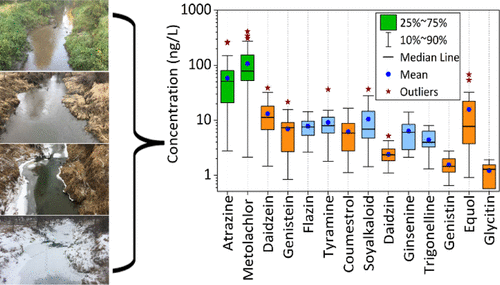当前位置:
X-MOL 学术
›
Environ. Sci. Technol.
›
论文详情
Our official English website, www.x-mol.net, welcomes your feedback! (Note: you will need to create a separate account there.)
Exposure and Transport of Alkaloids and Phytoestrogens from Soybeans to Agricultural Soils and Streams in the Midwestern United States
Environmental Science & Technology ( IF 11.4 ) Pub Date : 2021-08-03 , DOI: 10.1021/acs.est.1c01477 Jawameer R Hama 1 , Dana W Kolpin 2 , Gregory H LeFevre 3 , Laura E Hubbard 4 , Megan M Powers 3 , Bjarne W Strobel 1
Environmental Science & Technology ( IF 11.4 ) Pub Date : 2021-08-03 , DOI: 10.1021/acs.est.1c01477 Jawameer R Hama 1 , Dana W Kolpin 2 , Gregory H LeFevre 3 , Laura E Hubbard 4 , Megan M Powers 3 , Bjarne W Strobel 1
Affiliation

|
Phytotoxins are naturally produced toxins with potencies similar/higher than many anthropogenic micropollutants. Nevertheless, little is known regarding their environmental fate and off-field transport to streams. To fill this research gap, a network of six basins in the Midwestern United States with substantial soybean production was selected for the study. Stream water (n = 110), soybean plant tissues (n = 8), and soil samples (n = 16) were analyzed for 12 phytotoxins (5 alkaloids and 7 phytoestrogens) and 2 widely used herbicides (atrazine and metolachlor). Overall, at least 1 phytotoxin was detected in 82% of the samples, with as many as 11 phytotoxins detected in a single sample (median = 5), with a concentration range from below detection to 37 and 68 ng/L for alkaloids and phytoestrogens, respectively. In contrast, the herbicides were ubiquitously detected at substantially higher concentrations (atrazine: 99% and metolachlor: 83%; the concentrations range from below detection to 150 and 410 ng/L, respectively). There was an apparent seasonal pattern for phytotoxins, where occurrence prior to and during harvest season (September to November) and during the snow melt season (March) was higher than that in December–January. Runoff events increased phytotoxin and herbicide concentrations compared to those in base-flow conditions. Phytotoxin plant concentrations were orders of magnitude higher compared to those measured in soil and streams. These results demonstrate the potential exposure of aquatic and terrestrial organisms to soybean-derived phytotoxins.
中文翻译:

美国中西部从大豆到农业土壤和河流的生物碱和植物雌激素的暴露和运输
植物毒素是天然产生的毒素,其效力类似于/高于许多人为微污染物。然而,关于它们的环境命运和场外运输到溪流的情况知之甚少。为了填补这一研究空白,研究选择了美国中西部六个具有大量大豆产量的盆地网络进行研究。溪水 ( n = 110)、大豆植物组织 ( n = 8) 和土壤样品 ( n= 16) 分析了 12 种植物毒素(5 种生物碱和 7 种植物雌激素)和 2 种广泛使用的除草剂(阿特拉津和异丙甲草胺)。总体而言,在 82% 的样本中检测到至少 1 种植物毒素,在单个样本中检测到多达 11 种植物毒素(中位数 = 5),生物碱和植物雌激素的浓度范围从低于检测到 37 和 68 ng/L , 分别。相比之下,普遍检测到的除草剂浓度明显较高(阿特拉津:99% 和异丙甲草胺:83%;浓度范围分别从低于检测到 150 和 410 ng/L)。植物毒素有明显的季节性规律,在收获季节(9 月至 11 月)和融雪季节(3 月)之前和期间的发生率高于 12 月至 1 月。与基流条件相比,径流事件增加了植物毒素和除草剂的浓度。与在土壤和溪流中测量的浓度相比,植物毒素植物的浓度要高几个数量级。这些结果表明水生和陆生生物可能接触大豆衍生的植物毒素。
更新日期:2021-08-17
中文翻译:

美国中西部从大豆到农业土壤和河流的生物碱和植物雌激素的暴露和运输
植物毒素是天然产生的毒素,其效力类似于/高于许多人为微污染物。然而,关于它们的环境命运和场外运输到溪流的情况知之甚少。为了填补这一研究空白,研究选择了美国中西部六个具有大量大豆产量的盆地网络进行研究。溪水 ( n = 110)、大豆植物组织 ( n = 8) 和土壤样品 ( n= 16) 分析了 12 种植物毒素(5 种生物碱和 7 种植物雌激素)和 2 种广泛使用的除草剂(阿特拉津和异丙甲草胺)。总体而言,在 82% 的样本中检测到至少 1 种植物毒素,在单个样本中检测到多达 11 种植物毒素(中位数 = 5),生物碱和植物雌激素的浓度范围从低于检测到 37 和 68 ng/L , 分别。相比之下,普遍检测到的除草剂浓度明显较高(阿特拉津:99% 和异丙甲草胺:83%;浓度范围分别从低于检测到 150 和 410 ng/L)。植物毒素有明显的季节性规律,在收获季节(9 月至 11 月)和融雪季节(3 月)之前和期间的发生率高于 12 月至 1 月。与基流条件相比,径流事件增加了植物毒素和除草剂的浓度。与在土壤和溪流中测量的浓度相比,植物毒素植物的浓度要高几个数量级。这些结果表明水生和陆生生物可能接触大豆衍生的植物毒素。


























 京公网安备 11010802027423号
京公网安备 11010802027423号